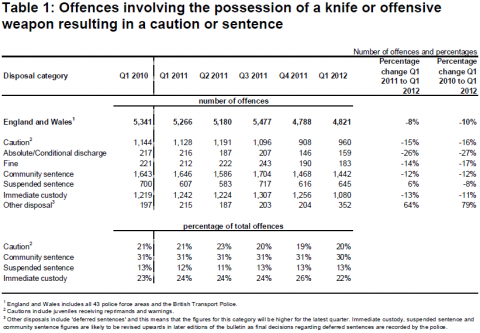Are one in five knife criminals cautioned?
"One in every five knife thugs gets away with a caution... despite ministerial promises to crackdown on offenders"
Daily Mail, 8 June 2012
The Daily Mail has published a short piece on sentencing statistics for possession of knives or offensive weapons.
It claims that a fifth of people convicted of possessing a knife or offensive weapon were jailed, giving several figures to back up its claim. Where have these figures been taken from, and are they accurate?
Join 72,953 people who trust us to check the facts
Sign up to get weekly updates on politics, immigration, health and more.
Subscribe to weekly email newsletters from Full Fact for updates on politics, immigration, health and more. Our fact checks are free to read but not to produce, so you will also get occasional emails about fundraising and other ways you can help. You can unsubscribe at any time. For more information about how we use your data see our Privacy Policy.
Statistics for knife or offensive weapon sentencing
Crown Prosecution Service guidelines show that several possible offences exist which cover knife and offensive weapon possession.
However the Ministry of Justice (MoJ) Knife Possession Sentencing Quarterly Briefs - which the article is almost certainly based upon - lumps knife and offensive weapon possession together.
In other words, the figures looked at in the MoJ statistics include both possession of an offensive weapon under section 1 of the Prevention of Crime Act 1953 and having an article with a blade or point in a public place under section 139 of the Criminal Justice Act 1988.
Examining these MoJ figures, it would appear that the Mail reported its figures correctly.
The figures confirm that 4,821 court disposals (which the article referred to as sentencings), 1,080 were sentenced to immediate custody, 960 were cautioned, 1,442 were given community sentences, 645 were given suspended sentence orders, and 183 were fined.
As 960 cautions out of 4,821 disposals comes out at just under 20 per cent, we can say that the Daily Mail's claim that one in five are cautioned was correct.
Could more have been said?
While the numbers reported by the Daily Mail are accurate, some canny readers might have noticed that the sum total of offences reported by the newspaper comes to just 4,310. Some 511 court disposals appear to be missing.
So can these errant criminals be tracked down with the power of statistics?

As we can see in the table above, taken from the MoJ data, the Daily Mail did not mention the 159 absolute and conditional discharges (which are counted together in the MoJ statistics) and 352 other disposals (which include deferred sentences). This is perhaps surprising since these examples support the Mail's case.
But is there anything to say about how sentencing might has changed over the years?
If nothing else, the MoJ statistics helpfully provide a table which lets us see the proportion of cautions, community sentences, suspended sentences and immediate custody since the first quarter of 2008 at a glance:

The proportion of cautions has actually dropped sharply since the first quarter of 2008. So the one in five claim might sound high, but it is worth bearing in mind that the proportion was around 15 percentage points higher in the first quarter of 2008.
Conclusion
While the Daily Mail's claim and numbers can't be faulted, it is worth bearing in mind the wider context to the figures.
It's true that cautions account for a fifth of court disposals, but this figure was just over one in three in early 2008 — the MoJ statistics referred to here even carried a table which showed this at a glance.